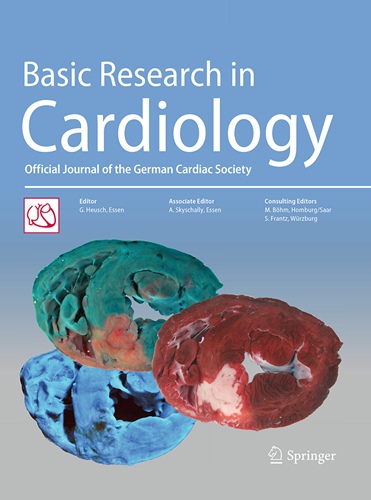NLRP3 mediates lipid-driven macrophage proliferation in established atherosclerosis.
IF 8
1区 医学
Q1 CARDIAC & CARDIOVASCULAR SYSTEMS
引用次数: 0
Abstract
An increased number of macrophages in the atherosclerotic plaque is associated with plaque instability and plaque progression. Lowering systemic cholesterol levels suppresses local macrophage proliferation and leads to plaque regression. However, the pathways regulating macrophage proliferation remain poorly understood. We investigated the cellular processes that underlie lipid-triggered local macrophage proliferation in the atherosclerotic plaque in transgenic mice and in human plaque tissue samples. Macrophages from mice with genetic deficiencies in scavenger receptors Cd36-/- and Msr1-/- showed reduced lipid uptake, lower intracellular lipid content, and lower proliferation compared to wild type macrophages. Double knockouts for the cholesterol exporters Abca1 and Abcg1 (MAC-ABC-DKO) showed increased rates of macrophage proliferation and apoptosis. In Cd36-/-, Msr1-/-, and MAC-ABC-DKO mixed bone marrow chimeras, no differences in chimerism were observed in blood or aorta after 4 weeks on a high-cholesterol diet. After 12 weeks of atherogenic diet, wild type macrophages predominated in the aorta since they proliferated more than neighboring Cd36-/- or Msr1-/- macrophages, and were less apoptotic than ABC-DKO macrophages, respectively. Knockout of NLRP3, but not ASC, Caspase 1 or IL-1 receptor, limited macrophage proliferation; indicating an NLRP3-dependent, but inflammasome-independent, effect. Inhibition of NLRP3 by MCC950 in human carotid artery plaque tissue cultures resulted in the suppression of intra-plaque macrophage proliferation and IL-1β release consistent with murine in vivo data. We identified a novel role for NLRP3 in driving macrophage proliferation in atherosclerotic plaques. NLRP3 inhibition may represent an ideal therapeutic target in atherosclerosis by combining anti-inflammasome and anti-proliferative effects in macrophages.NLRP3介导脂质驱动的巨噬细胞在动脉粥样硬化中的增殖。
动脉粥样硬化斑块中巨噬细胞数量的增加与斑块不稳定和斑块进展有关。降低全身胆固醇水平可抑制局部巨噬细胞增殖并导致斑块消退。然而,调控巨噬细胞增殖的途径仍然知之甚少。我们在转基因小鼠和人类斑块组织样本中研究了脂质引发的动脉粥样硬化斑块局部巨噬细胞增殖的细胞过程。与野生型巨噬细胞相比,清道夫受体Cd36-/-和Msr1-/-基因缺陷小鼠巨噬细胞的脂质摄取减少,细胞内脂质含量降低,增殖降低。双敲除胆固醇输出蛋白Abca1和Abcg1 (MAC-ABC-DKO)显示巨噬细胞增殖和凋亡率增加。在Cd36-/-、Msr1-/-和MAC-ABC-DKO混合骨髓嵌合体中,在高胆固醇饮食4周后,血液或主动脉的嵌合性没有观察到差异。在致动脉粥样硬化饮食12周后,野生型巨噬细胞在主动脉中占主导地位,因为它们比邻近的Cd36-/-或Msr1-/-巨噬细胞增殖更多,并且分别比ABC-DKO巨噬细胞更少凋亡。敲除NLRP3,而不敲除ASC、Caspase 1或IL-1受体,可抑制巨噬细胞的增殖;表明nlrp3依赖,但炎症小体无关。mc950在人颈动脉斑块组织培养中抑制NLRP3导致斑块内巨噬细胞增殖和IL-1β释放受到抑制,与小鼠体内数据一致。我们发现NLRP3在动脉粥样硬化斑块中驱动巨噬细胞增殖中的新作用。通过抑制巨噬细胞的抗炎体和抗增殖作用,NLRP3可能是动脉粥样硬化的理想治疗靶点。
本文章由计算机程序翻译,如有差异,请以英文原文为准。
求助全文
约1分钟内获得全文
求助全文
来源期刊

Basic Research in Cardiology
医学-心血管系统
CiteScore
16.30
自引率
5.30%
发文量
54
审稿时长
6-12 weeks
期刊介绍:
Basic Research in Cardiology is an international journal for cardiovascular research. It provides a forum for original and review articles related to experimental cardiology that meet its stringent scientific standards.
Basic Research in Cardiology regularly receives articles from the fields of
- Molecular and Cellular Biology
- Biochemistry
- Biophysics
- Pharmacology
- Physiology and Pathology
- Clinical Cardiology
 求助内容:
求助内容: 应助结果提醒方式:
应助结果提醒方式:


